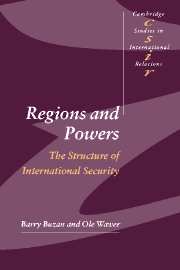Book contents
- Frontmatter
- Contents
- List of illustrations
- Preface
- List of abbreviations
- 1 Patterns of regional security during the Cold War
- 2 Patterns of regional security post-Cold War
- Part I Introduction: developing a regional approach to global security
- Part II Asia
- Part III The Middle East and Africa
- Part IV The Americas
- Part V The Europes
- Part VI Conclusions
- Introduction
- 14 Regions and powers: summing up and looking ahead
- 15 Reflections on conceptualising international security
- Glossary
- References
- News media
- Index of names
- General Index
- CAMBRIDGE STUDIES IN INTERNATIONAL RELATIONS
15 - Reflections on conceptualising international security
Published online by Cambridge University Press: 05 December 2009
- Frontmatter
- Contents
- List of illustrations
- Preface
- List of abbreviations
- 1 Patterns of regional security during the Cold War
- 2 Patterns of regional security post-Cold War
- Part I Introduction: developing a regional approach to global security
- Part II Asia
- Part III The Middle East and Africa
- Part IV The Americas
- Part V The Europes
- Part VI Conclusions
- Introduction
- 14 Regions and powers: summing up and looking ahead
- 15 Reflections on conceptualising international security
- Glossary
- References
- News media
- Index of names
- General Index
- CAMBRIDGE STUDIES IN INTERNATIONAL RELATIONS
Summary
This chapter reflects on a number of points about regional security complex theory (RSCT) and its application. The first section reconsiders the validity of the two starting assumptions about security that structured this study: territoriality and the regional level. The next section looks at the comparative element of RSCT, drawing together a series of questions that can be asked about all regions, and taking a first cut at some conclusions based on the present exercise. The third section sums up what we think are the advantages of the regionalist approach to security. Finally, the last section sets out some of the problems that arose for us in applying RSCT.
Starting assumptions: territoriality and the regional level of security analysis
When we began this project in 1998, the two starting assumptions that structured it were that territoriality still remained a central feature of international security dynamics, and that the regional level was both generally necessary to any coherent understanding of international security and increasingly important in the post-Cold War world. The logic linking these assumptions was that processes of securitisation would be strongly influenced by the fact that most types of threat travel more easily over short distances than long ones, and that this logic remained strong despite the numerous and well-rehearsed advances in technology that have been shrinking the planet for several centuries. How well have these assumptions stood up, both in general and under the specific challenge of international terrorism manifested since 11 September?
- Type
- Chapter
- Information
- Regions and PowersThe Structure of International Security, pp. 461 - 488Publisher: Cambridge University PressPrint publication year: 2003



